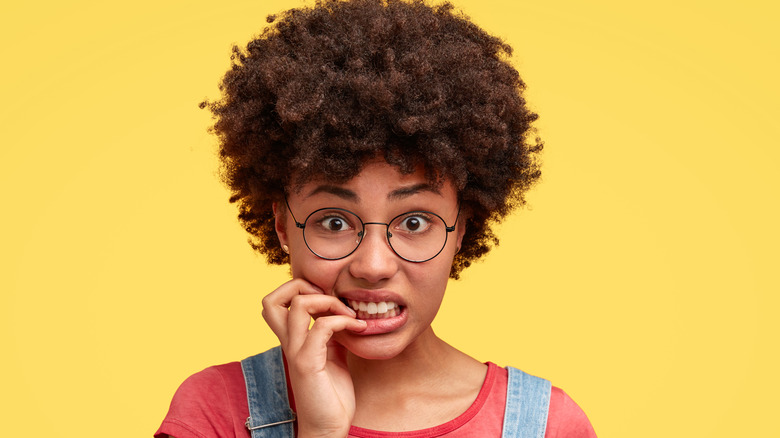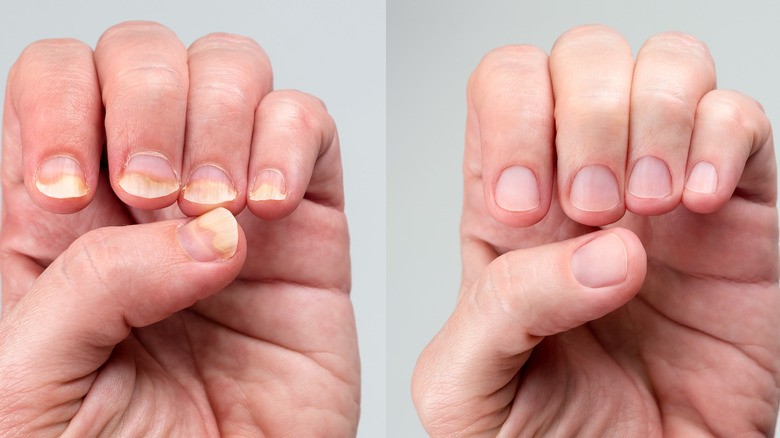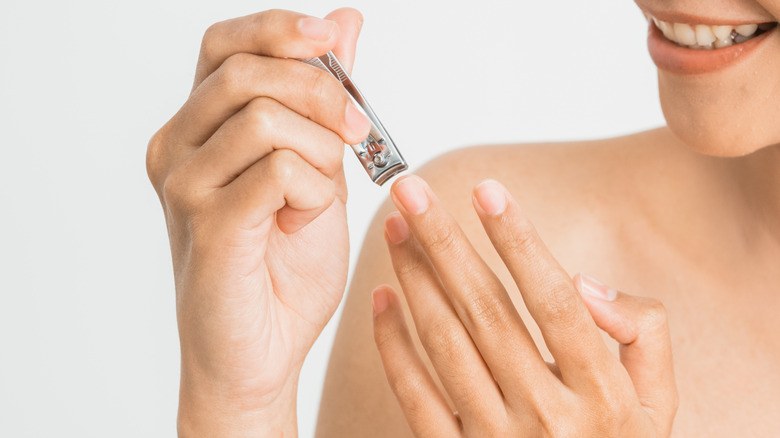If Your Nails Are Yellow After Having Acrylics, This Could Be Why
People love a manicure for all the right reasons: it pulls your look together, makes your hands look smoother and younger, and protects your nails from infection. When you hit a nail salon in this day and age, you'll be overwhelmed by a broad selection of nail polishes. From chrome nails to gel polishes to glitter finishes, there are plenty of nail services to choose from. Among them, acrylics stand out as the type of polish that can alter the shape and add length to your fingertips with extensions over your natural nail, per StyleCraze.
Made from a mixture of liquid and powder by a nail technician during your mani, this combination is shaped onto your bare nail with a brush, and air-dried. After that, acrylic nail polish thickens and can be filed to your desired shape. Thanks to their nail-extending and strengthening powers, acrylics — which usually last around two weeks — are perfect for nail biters and fans of dramatic nail arts. However, many people notice yellow spots on their nails after acrylic treatments. And discoloration, dear reader, is the antithesis of health. If your nails take on a yellow hue after having acrylics, this could be why.
Why your nails are yellow after having acrylics
Nail solutions, including acrylics, contain chemicals that can take a toll on your natural nails in the long run, per The University of Pittsburgh Medical Center. When the seal between the solution and your nail comes loose, a nail fungus can invade your nail bed. As a result, you might notice signs of discoloration like green, white, or yellow spots on your nails, which necessitate a visit to the doctor.
Echoing this point of view, cosmetic dermatologist Michele Green M.D. tells Byrdie that discoloration "of the natural nail can mean that there is an infection or nail fungus." A prolonged yellow tint on the nail might be a sign of vitamin or mineral deficiencies, which are even more serious. Green added that "nails that remain yellow despite treatment can be a symptom of thyroid conditions, psoriasis, or diabetes." Furthermore, formaldehyde, a notorious component of acrylics, interacts with the keratin protein in your nail to turn it yellow. Your natural nails may become brittle and more prone to breaking over time if you frequently apply and remove artificial nails. While discoloration tends to fade away on its own, there are some hacks you can try to prevent or lessen the yellowing effect after having acrylics.
How to reduce nail yellowing
According to Guardian, soaking your nails in a hydrogen peroxide solution, an antiseptic liquid used to destroy germs and often found in whitening toothpaste, can reduce yellowing. To do this, make a solution of diluted hydrogen peroxide at a 1:3 ratio of 1 part peroxide to 3 parts water, and bathe your nails in it for about 10 to 20 minutes. For more effective and quicker results, add some baking soda. Then, rinse your hands with warm water and pat them dry. Applying vitamin E topically to your yellowing nails is another way to give them a nutritional boost and speed up their growth. Ingredients containing antimicrobial properties, such as oregano oil and tea tree oil, are also effective against germs. However, keep in mind that home cures don't always work, and you may need to see a physician.
Although home remedies are available, you can also prevent nail discoloration by practicing nail care. To keep your nails clean, refrain from applying nail polish remover on your nails more than once a week, Healthline advises. It's also helpful to choose a remover that doesn't contain acetone. Before visiting any nail salon, do your research on its certification requirements, hygienic practices, and product quality to ensure you enjoy a safe and pleasant manicure experience.


